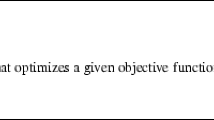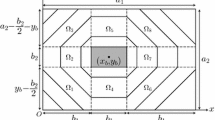Abstract
This paper presents an analytical model for determining the number of point-like facilities and the length of line-like facilities. The proportions of area covered within a distance from the first and second nearest facilities are derived for grid and random patterns. The analytical expressions for the proportions of covered area demonstrate how the coverage distance, the number (length) of facilities, and the pattern of facilities affect the level of coverage. The number (length) of facilities required to achieve a certain level of coverage is then obtained. The level of coverage is represented as the combination of the coverage distance and the proportion of covered area. The model that incorporates any level of coverage and the secondary coverage helps planners with their location decisions.















Similar content being viewed by others
References
Berman O, Drezner Z, Krass D (2010) Cooperative cover location problems: the planar case. IIE Trans 42:232–246
Church R, ReVelle C (1974) The maximal covering location problem. Pap Reg Sci Assoc 32:101–118
Clark P, Evans F (1954) Distance to nearest neighbor as a measure of spatial relationships in populations. Ecology 35:85–90
Current J, O’Kelly M (1992) Locating emergency warning sirens. Decis Sci 23:221–234
Dacey M (1968) Two-dimensional random point patterns: a review and an interpretation. Pap Reg Sci Assoc 13:41–55
Daskin M (1983) A maximum expected covering location model: formulation, properties and heuristic solution. Transp Sci 17:48–70
Daskin M, Stern E (1981) A hierarchical objective set covering model for emergency medical service vehicle deployment. Transp Sci 15:137–152
Drezner T, Drezner Z, Kalczynski P (2019) A directional approach to gradual cover. Top 27:70–93
Drezner Z (1986) Location of regional facilities. Nav Res Logist Q 33:523–529
Du Q, Faber V, Gunzburger M (1999) Centroidal Voronoi tessellations: applications and algorithms. SIAM Rev 41:637–676
Farahani R, Asgari N, Heidari N, Hosseininia M, Goh M (2012) Covering problems in facility location: a review. Comput Ind Eng 62:368–407
Gleason J (1975) A set covering approach to bus stop location. Omega 3:605–608
Hogan K, ReVelle C (1986) Concepts and applications of backup coverage. Manag Sci 32:1434–1444
Iri M, Murota K, Ohya T (1984) A fast Voronoi diagram algorithm with applications to geographical optimization problems. In: Throft-Christensen P (ed) Proceedings of the 11th IFIP conference on system modelling and optimization. Springer, Berlin, pp 273–288
Karatas M (2017) A multi-objective facility location problem in the presence of variable gradual coverage performance and cooperative cover. Eur J Oper Res 262:1040–1051
Koshizuka T (1985) On the relation between the density of urban facilities and the distance to the nearest facility from a point in a given area. J City Plan Inst Jpn 20:85–90 (in Japanese)
Leamer E (1968) Locational equilibria. J Reg Sci 8:229–242
Miyagawa M (2009) Order distance in regular point patterns. Geogr Anal 41:252–262
Miyagawa M (2010) Distributions of rectilinear deviation distance to visit a facility. Eur J Oper Res 205:106–112
Miyagawa M (2012) Joint distribution of distances to the first and the second nearest facilities. J Geogr Syst 14:209–222
Miyagawa M (2017) Continuous location model of a rectangular barrier facility. Top 25:95–110
Murray A (2005) Geography in coverage modeling: exploiting spatial structure to address complementary partial service of areas. Ann Assoc Am Geogr 95:761–772
Murray A, Tong D, Kim K (2010) Enhancing classic coverage location models. Int Reg Sci Rev 32:115–133
Okabe A, Boots B, Sugihara K, Chiu S (2000) Spatial tessellations: concepts and applications of voronoi diagrams. Wiley, Chichester
O’Kelly M, Murray A (2004) A lattice covering model for evaluating existing service facilities. Pap Reg Sci 83:565–580
Persson O (1964) Distance methods: the use of distance measurements in the estimation of seedling density and open space frequency. Stud For Suec 15:1–68
Plane D, Hendrick T (1977) Mathematical programming and the location of fire companies for the Denver fire department. Oper Res 25:563–578
Sadahiro Y (2005) Spatiotemporal analysis of the distribution of urban facilities in terms of accessibility. Pap Reg Sci 84:61–84
Savaş S, Batta R, Nagi R (2002) Finite-size facility placement in the presence of barriers to rectilinear travel. Oper Res 50:1018–1031
Santaló L (2004) Integral geometry and geometric probability. Cambridge University Press, Cambridge
Schöbel A (1999) Locating lines and hyperplanes: theory and algorithms. Kluwer Academic Publishers, Dordrecht
Thompson H (1956) Distribution of distance to \(n\)th neighbour in a population of randomly distributed individuals. Ecology 37:391–394
Toregas C, Swain R, ReVelle C, Bergman L (1971) The location of emergency service facilities. Oper Res 19:1363–1373
Acknowledgements
This research was supported by JSPS KAKENHI Grant Numbers JP18K04604, JP18K04628, JP19H02374. I am grateful to anonymous reviewers for their helpful comments and suggestions.
Author information
Authors and Affiliations
Corresponding author
Additional information
Publisher's Note
Springer Nature remains neutral with regard to jurisdictional claims in published maps and institutional affiliations.
Rights and permissions
About this article
Cite this article
Miyagawa, M. Optimal number and length of point-like and line-like facilities of grid and random patterns. TOP 28, 213–230 (2020). https://doi.org/10.1007/s11750-019-00532-2
Received:
Accepted:
Published:
Issue Date:
DOI: https://doi.org/10.1007/s11750-019-00532-2




